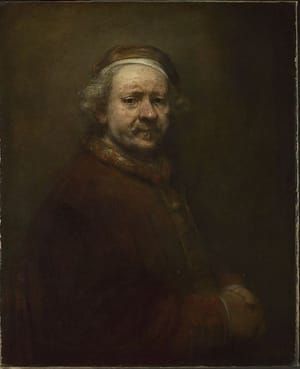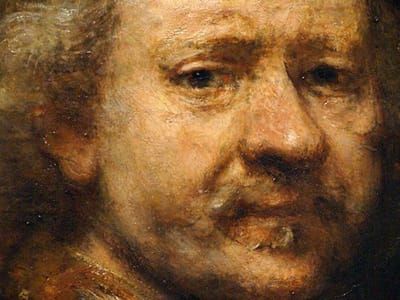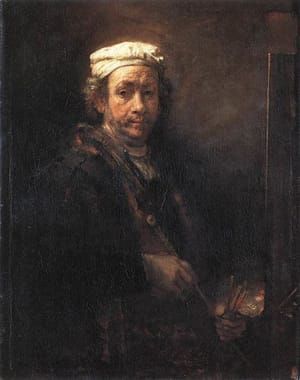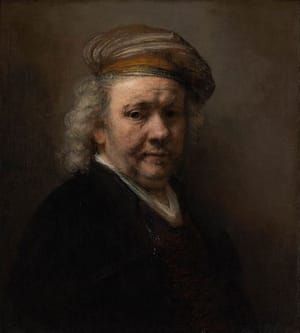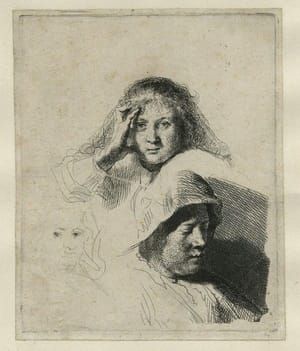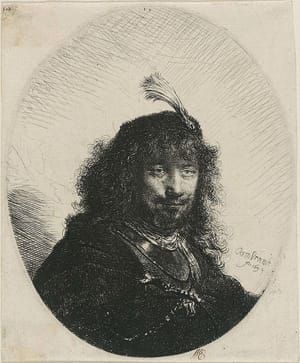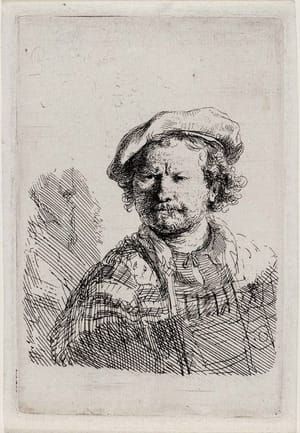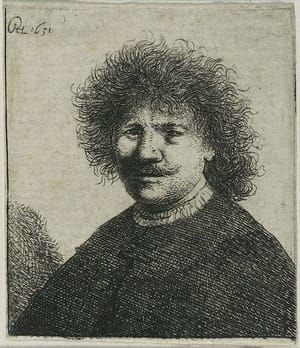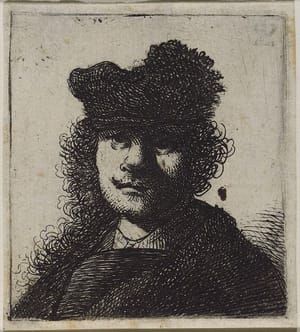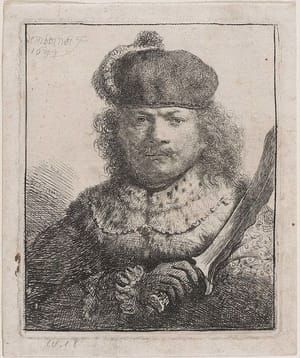
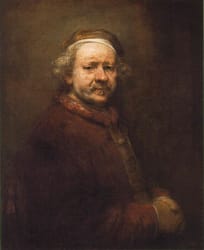
Self Portrait at the Age of 63, 1669
Rembrandt van Rijn
Self-Portrait at the Age of 63 is a self-portrait by the Dutch artist Rembrandt, now in the National Gallery, London. Dating to 1669, it was the last in his long series of self-portraits, and painted in the year of his death. Despite the closeness of his death, Rembrandt makes an impression of a self-assured and confident artist.
The painting was investigated by the scientists of the National Gallery in London. Rembrandt employed his usual rather limited palette of lead white, ochres and red lakes.
(https://en.wikipedia.org/wiki/Self-portrait_at_the_age_of_63)
Rembrandt made the portrait philosophical. He even painted a portrait of a philosopher: Aristotle Contemplating the Bust of Homer (1653), in the Metropolitan Museum of Art, New York, makes explicit the problems of memory, history, and selfhood that haunt every Rembrandt portrait.
None of his portraits is an observed document of a person's appearance. Each is a questioning of what it is to exist. Each tries to get at the invisible mind, soul, character - whatever you call the inner person, Rembrandt paints it. His paintings are not concerned with visual pleasure for its own sake, but only in so far as it leads to knowledge.
He strips away almost everything that interested other Dutch artists - the facts of the material world - to convey a sense of the immaterial. Darkness is his friend, because in darkness the self is isolated. Light is not recorded as an optical fact but used theatrically. He loves gold, bronze, brown - warm, living colors. However he does it, the effect is constantly shocking: a room of Rembrandt portraits is a formidable place.
Rembrandt painted his own portrait frequently, from his amazing 1629 work The Artist in His Studio (in the Museum of Fine Arts, Boston, it shows the young painter standing back from his canvas in a moment of courage and dread, aware of the scale of his task) to this, one of his last paintings, done in the final year of his life.
For a painter interested in the mystery of identity, there was no richer subject than his ever-changing self. Rembrandt is never the same in two portraits, never dressed the same, never in the same mood. He tries on exotic costumes, poses - because each time he is trying to discover who he is. As he gets older, this essential Rembrandt comes out of fancy dress, drops the masks and the fantasies, and looks himself and us in the eye with a directness that is unparalleled in art.
This is not like looking at a painting. It is like meeting Rembrandt. You have no idea what to say to him, and fear what he is about to say to you.
Of course, he has given himself a hell of a send-off in this valedictory painting. Rembrandt finds himself intensely moving as a subject. The rich subdued glow of the picture, the light filling his wonderful old face, the subtle magnificence of his clothes, the dignity of his pose, with his hands clasped and his head turned patiently towards us as if bearing immense pain with tragic endurance: this painting would communicate agony and acceptance even if we knew nothing about Rembrandt's life, the spectacular success followed by bankruptcy and, by this time, the deaths of almost everyone he loved; his son Titus predeceased him in this same year.
The painting is full of pride beneath all his suffering; perhaps pride in his suffering - and pride in his art, which can make his image live like this. No wonder he originally gave himself a brush and maulstick - a final bit of professional pride revealed only by x-rays.
But he painted them out. He chose to be a man, not an artist, in this painting, and to claim no dignity except that which everyone deserves. It is so intense you feel Rembrandt is still painting it and we are always seeing it for the first time - his long goodbye.
(https://www.theguardian.com/culture/2004/feb/28/art)
This work was painted in the final year of Rembrandt's life and is one of his last pictures. He died on 4 October 1669 and was buried in the Westerkerk in Amsterdam.
Rembrandt painted more self portraits than any other artist of the 17th century. The National Gallery has two of them, separated by nearly thirty years. In this late picture, the artist wears a deep red coat and a beret, his hands clasped before him. The viewer is confronted by his steady gaze. Rembrandt painted and etched self portraits throughout his life, but those executed in his final years, in which he presents himself in a reflective mood, are among the most poignant and challenging.
The painting was cleaned in 1967, revealing the damaged signature and date. The X-ray of the picture reveals two pentimenti (alterations to the design). First, a change in the size and colour of the beret, which was originally much larger and all white. Secondly, the original position of the hands was open and he was holding a paintbrush. Repainting the hands clasped and without the brush reduces their dramatic impact and draws attention back to the face.
https://www.nationalgallery.org.uk/paintings/rembrandt-self-portrait-at-the-age-of-63
34 x 28 in
© 1669 Rembrandt van Rijn
Rembrandt van Rijn
artistArthur
coming soon
